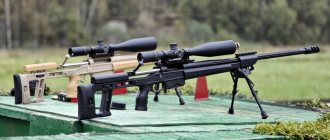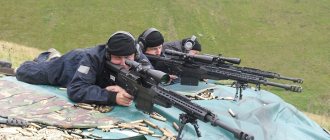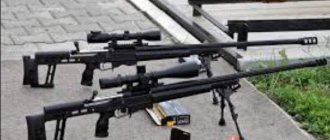This term has other meanings, see M110.
| M110 | |
| M110 | |
| Type | sniper rifle/marksman rifle |
| A country | USA |
| Service history | |
| Years of use | 2007 - present |
| Adopted | 2008 |
| Wars and conflicts | War in Afghanistan (since 2001), Iraq War |
| Production history | |
| Manufacturer | Knight's Armament Company |
| Years of production | September 2005 - present[1] |
| Total issued | 4,492 (US Army procurement plan)[1] |
| Characteristics | |
| Weight, kg | 7.26 (with silencer, bipod, MIL-STD-1913 rail, optical sight, unloaded 10-round magazine)[2] |
| Length, mm | 1219[2] |
| Barrel length, mm | 508 |
| Cartridge | 7.62x51mm NATO |
| Caliber, mm | 7,62 |
| Work principles | removal of powder gases, rotary bolt |
| Initial bullet speed, m/s | 783 |
| Sighting range, m | 1000 800 (effective)[2] |
| Type of ammunition | box magazine for 10 or 20 rounds |
| Aim | main optical, backup dioptric |
| Media files on Wikimedia Commons | |
M110
(Rifle, 7.62 mm: Semi-Automatic Sniper System (SASS) - M110[2]) is an American sniper rifle developed by Knight's Armament Company based on the Mk11 mod. 0 to complement and replace the US Army M24 sniper rifle[1].
Characteristics[ | ]
The requirements for the new army rifle were formulated by the US Army Armaments Research, Development & Engineering Center and were as follows[1]:
- effective destruction of enemy personnel at a distance of up to 1000 m;
- the ability to use M118LR and M993 AR (armor-piercing) cartridges;
- the probability of normal functioning without EFFs (Essential Function Failures - critical failures that cannot be eliminated by the shooter) when shooting 300 rounds under normal conditions with a daytime optical sight is at least 90% (98% optimal);
- the probability of normal functioning without EFFs when shooting 100 rounds in combat conditions with a daytime optical sight is at least 90% (98% optimal).
Notes
- The Military Balance 2007. - P. 220.
- ↑ 1 2 3 4 G. Kholyavsky
. Tracked combat vehicles: 1919—2000 - Mn.: Harvest, 2001. - P. 238. - (Encyclopedia of armored vehicles). — 11,000 copies. — ISBN 978-9-85-130035-4 - The Military Balance 2007. - P. 119.
- Deals in the Works 1996 (Federation of American Scientists)
- The Military Balance 2007. - P. 228.
- The Military Balance 2007. - P. 230.
- The Military Balance 2007. - P. 224.
- The Military Balance 2007. - P. 142.
- The Military Balance 2007. - P. 360.
- The Military Balance 2007. - P. 237.
- The Military Balance 2007. - P. 322.
- The Military Balance 2007. - P. 373.
- The Military Balance 2007. - P. 145.
- The Military Balance 2007. - P. 355.
Design and equipment[ | ]
Main differences from the earlier Mk11 mod.0
:[1]
- trigger mechanism with a two-stage trigger (Two Stage Trigger), which has a positive effect on shooting accuracy and makes the trigger at the same time quite fast with a predictable moment of firing;
- protective sand-colored coating;
- URX type forend with rail guides and a heat-protective barrel casing located inside;
- the folding front sight is integrated into the design of the upper segment of the M1913 guide on the forend;
- butt adjustable in length;
- two additional swivels on the butt;
- a channel in the charging handle to remove residual powder gases away from the shooter’s face when using a silencer;
- monolithic type bracket for mounting an optical sight.
The M110 is equipped with an XM151 optical sight (Leupold Mark 4 3.5-10X LR/T), which has a variable magnification of 3.5-10X and a Mil-Dot reticle. It is possible to use the AN/PVS-17 night sight, while the day sight is not dismantled, and the night sight is installed in front of it[1]. The rifle uses automatic gas venting with the removal of powder gases into the body of the bolt frame (Stoner system).
The weapon kit includes: the rifle itself, day optical and night sights, a bipod, cleaning accessories and maintenance tools, five magazines for 20 rounds, magazine pouches, a gun belt, a silencer, an instruction manual, a case for additional equipment and accessories, mat-mat HSRC (Hybrid Shooting Mat and Rifle Case) for equipping a sniper position (which is also a carrying case), soft rifle and travel protective cases and a transport case (which houses all other components of the kit)[1].
Dell M110 review: cinema in your pocket (updated)
The class of portable projectors, although small, is diverse. We recently told you about the ASUS P1M model, a small and almost omnivorous (in terms of connectivity and supported file formats) device. Today we will talk about one of its “classmates” - the Dell M110 pico projector. With many equal inputs (brightness, image resolution, almost the same set of connectors), both devices are very different from each other in critical parameters - such as dimensions, set of connectors, supported file formats.
| Dell M110 Specifications | |
| Dimensions | 104x105x36 mm |
| Weight | 360 g |
| Matrix type | DLP |
| Permission | 1280×800 pixels |
| Distance | from 1 to 2.6 m |
| Image diagonal | from 30 to 80 inches |
| Brightness | 300 lm |
| Contrast | 10000:1 |
| Number of colors displayed | 1.07 billion |
| Speaker | 1 Wx1 |
| Interfaces and connectors | VGA, HDMI, analog input, USB, microSD card slot |
Thanks to its modest size, the Dell Pico Projector quite honestly deserves to be called a pocket device. Its dimensions are 10x10x3.5 cm. The body is made of black glossy plastic, which tends to become covered with fingerprints. They are most noticeable on the top of the device. However, hardly anyone will look at fingerprints on the projector in the midst of showing a video (or presentation, or whatever else), the shortcomings of the materials will only be visible to those who are “at the helm.” In addition to its modest size, the body of the device is notable for the presence of a hole for mounting the projector on a tripod (we praise the creator), the absence of legs that would allow the projector to be raised above the surface, avoiding overheating if there is no tripod at hand (we shake our heads disapprovingly) and the presence of an HDMI connector in addition to VGA, analog output, memory card slot and flash drive connector (we approve). The model is equipped with one built-in speaker, but it is predictably bad, alas.
I really liked the included bag for transporting the projector. It holds not only the projector itself, but also the necessary cables and a hefty power supply, the size of a laptop. With all this goodness, it does not look sloppy (like the case for ASUS P1M) and is easy to transport. In addition, the package includes a disk with software, in particular, PtG2 Converter Lite for converting PowerPoint files into a format understandable for smartphones (works, by the way, if Microsoft Office is installed on the computer), 24 pin cable for connecting to VGA - computer connector.
In addition to numerous connectors, the Dell M110 also received 1 GB of internal memory. Thus, apart from the need for power supply, the M110 can be used completely independently from any other equipment. At the time of preparing the initial version of this review, a projector arrived with an old firmware version that did not support office documents and pdf files. And this was my main complaint about the device. Afterwards it turned out that the firmware update at the end of last year (and if you, reading these lines, are the owner of this model, be sure to update it) brought the main thing - Office Viewer. Now, to launch, for example, a presentation from the projector, you just need to put it on a flash drive, memory card or internal memory, go to the corresponding projector menu item - and voila. True, it seemed to me that the fonts were displayed somehow strangely, as if from a scanned image. It all looks like this:
Images are only supported in JPEG format. Things are better with support for video files. I ran AVI, MOV, MP4, MKV, MTS, MVW (in general, everything that was at hand) on the projector. He refused to reproduce only the last one. When playing MP4, MKV, artifacts appeared on the image in dynamic scenes. Therefore, it is worth considering that a laptop will be needed to play large videos or office documents.
This is how a video in MKV format plays periodically
The projector is controlled using five keys on the front panel. At first glance, the menu seemed confusing to me. Some settings (audio, video, images) are located in the main menu of the projector, others (mainly related to image quality, but also sound, slide shows) are called up using a key located just to the right of the main navigation block. True, after rummaging through the settings for some time, I was forced to admit that in general everything looked logical, although unusual, and it would be difficult for a person who picked up the device for the first time to figure it out right away. There are no complaints about the image quality - it is exactly what you would expect from a projector with its brightness (300 lm) and HD resolution. In the gallery of screenshots below there are many photos of the Dell M110 projector menu. Please note that they were made during the day in a room with rather dim lighting against the background of a gray spotted wall. Accordingly, you can see what you can expect from the projector during the day, with the caveat that the result will be better against a white wall. That is, it is quite possible to display images with good contrast on a not too sunny day. But the film, alas, requires a darker room.
Translation error - “me” instead of “menu”
The price for Dell M110 is now about 4000 UAH. Paired with an excellent set of connectors and pocket-sized dimensions, this makes it an attractive candidate for purchase both for portable use and, indeed, for home use. The new firmware has fixed the biggest problem of this model - the lack of support for office documents and pdf files by the projector software. Thanks to its compact size, a good included carrying bag, support for the necessary basic set of files, and the ability to mount on a tripod, the Dell M110 pico projector is a good solution for business audiences. And thanks to the reasonable price by class standards and good characteristics, it is also suitable for home and country use. Although in this case one can find fault with the fact that when playing MKV and MP4 directly from the projector, artifacts may appear in the image.
Operation[ | ]
[3]
The rifle finally entered service with the troops in 2008. The M110 rifle was used quite intensively in combat operations in Iraq and Afghanistan. As of today, it is known that the following complaints have been received from the troops about the M110 model:
- Unreliability of weapons
- Poor supply of spare parts
- Locking problems
- Poor quality control
- Lack of accuracy
- Low durability
It was also reported that some of the rifles were disassembled to replenish the remaining rifles with spare parts. The barrel, according to users, is not stable enough; after firing 500 shots, problems with accuracy were observed, which led to the replacement of the barrel.
However, according to the American military, these problems have now been eliminated.
In 2020, the American army abandoned the M110, and now the Marines and army special forces units are looking for a replacement.
Armament of PT-Sau T110E3
- Gun – 120 mm.
- Horizontal tilt angles - -: -15°…+15°.
- Vertical tilt angles - -: -10°…+20°.
- Initial flight speed of an armor-piercing projectile: 1067 m/s
- Initial flight speed of a cumulative projectile: 1143 m/s
- Initial flight speed of a high-explosive fragmentation projectile: 762 m/s
- Armor penetration of homogeneous armor at 900 meters:
- Armor-piercing, mm/degree: 221/30°
- Cumulative, mm/deg.: 330/30°
- Additional weapons:
- 7.62 mm coaxial machine gun. Another 12.7 mm machine gun was installed in the commander's cupola.
Tactical and Technical Characteristics of PT-Sau T110E3
Chopping
It is very difficult to talk about the characteristics of a self-propelled gun when not even a prototype was built and there were only drawings, without armor schemes, but it is known for sure that the armor of the front of the wheelhouse is mm/deg. - 127 mm/60°, and the gun mantlet - 203 mm.
From the armoring of the front of the wheelhouse, it can be assumed that the armoring of the sides of the wheelhouse is approximately the same, mm/deg. — 120mm-140mm/20°-40°
The armoring of the stern of the cabin is presumably the following, mm/deg. — 51mm/15°
Housing T110E3
It is very difficult to talk about the thickness of the front of the hull, even approximately, because it has changed several times, and has led to thickening of the armor and a decrease in slope, but we can say with confidence that it is more than 200mm.
Since the hull is visually similar to the hull of the M103 tank, we can tell the approximate thickness of the hull.
- Hull side (top), mm/deg. — 51/40°
- Hull side (bottom), mm/deg. — 44/30°
- Hull stern (top), mm/deg. — 38/30°
- Hull rear (bottom), mm/deg. — 25/60°
- Bottom, mm - 32-38
- Housing roof, mm - 25
Observational data, physical characteristics of the galaxy M110
| History of the study | |
| Opener | Charles Messier |
| opening date | August 10, 1773 |
| Designations | NGC 205 |
| Observational data | |
| Type | Dwarf elliptical galaxy |
| Right ascension | 00h 40m 22.075s |
| Declension | +41° 41′ 07,08″ |
| Distance | 2.9 million St. years |
| Visible dimensions (V) | 21,9′ × 10,9′ |
| Constellation | Andromeda |
| physical characteristics | |
| Radius | 5000 St. years |
Technical details of the M110 galaxy photograph
- Object: M110
- Other designations: NGC 205
- Object type: Dwarf elliptical galaxy
- Date/Time: 2011, January 23, at 03:25 UTC
- Position: Bifrost Astronomical Observatory
- Mount: Astro-Physics 1200GTO
- Telescope: Takahashi Epsilon 180 Hyperbolic Astrograph
- Camera : Canon EOS 550D (Rebel T2i) (Baader UV/IR filter)
- Exposure: 8 x 300s, f/2.8, ISO 800
- Original photo size: 3454 × 5179 pixels (17.9 MP); 11.5″ x 17.3″ @ 300 dpi








